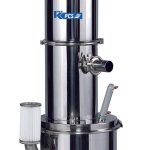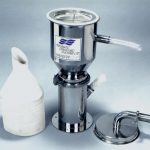Vacuum conveying for tabletting operations offers special advantages for material transfer including cleaner, dust free and contained operation with minimal product exposure. It also offers a gentle method to move a large volume of bulks especially in areas with height limitations, where gravity discharge from a large bin or tote may not be an option. Finally, the option to use either dense or dilute phase vacuum transfer offers much more versatility in powder transfer.
Sharon Nowak
Bulk transfer by pneumatic vacuum conveying has become one of the more popular means of transport for a wide variety of pharmaceutical, nutraceutical and food materials. The gentle use of vacuum in either dilute or dense phase ensures that the powder or granulate remains within the process, as opposed to leaks or losses that are often results of positive pressure transfer systems. The use of either dense or dilute phase vacuum can be applied to a wide variety of tablet operations including the loading of blenders, sifters, mills, capsule fillers, tablet presses and even finished tablet and capsule handling without damage to the finished product. Dilute phase conveying should be used with materials where segregation or attrition in the conveying line is not a concern. Comparative gas or air velocities in a 3” pipe for dilute phase can range from 15 up to 35 m/s. In most applications the gas is air, however, in the pharmaceutical industry, nitrogen is also widely used due to its inerting capabilities as well as the natural purity of the gas.
Without segregation
In dense phase operations, a reduced gas velocity range of 0.04 to only 9 m/s is utilised. The lower gas velocity means the force exerted on the conveyed powder or granulate is much gentler. This gentle action also reduces the segregation issues often experienced with the more aggressive dilute phase operation. It should be noted, however, that there are limitations to dense phase conveying. These limitations include conveying distances in excess of 3.6 m vertical and 4.6 m horizontal, and conveying materials which are cohesive, hygroscopic, or so coarse in particle size that they will not readily form slugs.
By definition, dense phase means a higher product to gas ratio, or a smaller amount of gas is used to move a large quantity of product. The less the gas requirement, the less the power consumed by the exhauster or vacuum pump. Typically material is picked up from the outlet of a specialty hopper, which creates a pressure differential and allows slugs of product to form. In addition, the hopper also includes a type of makeup air inlet, which aids in the forming of the slugs as they travel and pulse through the conveying line. The combination of the relatively low air velocity and an expanded line size result in a type of siphon-like effect for conveying to the vacuum receiver, with less resultant attrition and segregation.
Vacuum receiver
Regardless of the type of conveying technique used (dilute or dense), the material is delivered directly to a vacuum receiver, which allows for the break of the vacuum and the release of the material from the gas stream. This receiver includes a reverse jet filter, which is pulsed when the vacuum breaks to allow for cleaning of the filter media. The outlet of the receiver includes a valve, either flap type or butterfly. This valve is sequenced to open after the vacuum breaks and the filter has been pulsed, thus delivering product to the process below. K-Tron Premier PCS’s line of pneumatic receivers offers a wide variety of filter options dependent upon the application. For the pharmaceutical industry, special PTFE coated wide pleat membrane filters with stainless steel end caps are utilized to ensure maximum filter efficiency and optimal cleaning capability. The Premier PCS line of vacuum receivers offers an easy-to-clean design for ease of operation and maintenance. All flanges are affixed with means of sanitary triclover type clamps, thus resulting in disassembly without tools. All system components are designed to ensure the optimum in powder handling specific to the process requirements. Specialised options in wash-in-place designs, swing out filter heads for height restrictions and HEPA filtration are all available depending upon the application and process. All pneumatic solutions, including the product pickup option, are engineered with operator and product safety, superior ergonomic design and ease of maintenance in mind.
The conveying of filled capsules or tablets requires special modifications to the pneumatic receiver in order to avoid any dam-age to the product. Due to the individual particle density of filled capsules or tablets, and their overall higher mass, a lower overall velocity of the individual tablet results. In other words, a small granulate weighing much less will move a lot faster in equivalent gas velocities than a tablet the size of an aspirin. In order to balance the higher required gas velocities, the inlet to the receiver is tangential and expanded, to allow for a natural deceleration of the product before it enters the receiver. In addition, the receiver is often lined with a soft food grade rubber liner to avoid any product degredation which may occur after impact to a standard stainless steel receiver.
Vacuum conveying, via dense or dilute phase, is the logical choice for efficient bulk transfer. It offers a gentle method to move a large volume of material especially in areas with height limitations, where gravity discharge from a large bin or tote may not be an option. Finally, the option to use either dense or dilute phase vacuum transfer offers much more versatility in powder transfer. Both individual ingredients as well as powder blends can be conveyed without worry of segregation or attrition on the product.
cpp 455
Share:









